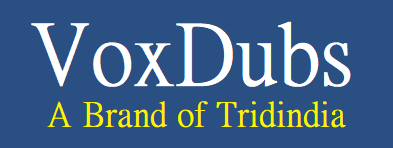Voice-over artists and dubbing artists are both crucial players in the world of audiovisual content localization. While they share similarities in their work of providing voices for characters and narrations, there are significant differences in their roles, techniques, and the context in which they operate. In this blog, we will explore the distinctions between voice-over artists and dubbing artists to shed light on their respective contributions to the entertainment industry.
Voice-Over Artist:
1. Definition
A voice-over artist is a skilled performer who lends their voice to characters, narrations, commercials, documentaries, e-learning modules, and various other audio content. Voice-over artists typically record their performances in a studio while watching the visuals on screen. Their voice is overlaid onto the original content, and viewers can hear both the original audio (often at a lower volume) and the translated accurate voice-over.
2. Role and Purpose
The primary role of a voice-over artist is to provide a clear, expressive, and engaging voice that complements the visuals or audio content. They often work in informational or educational contexts, such as e-learning courses or documentary narrations, where the focus is on conveying information rather than matching lip movements.
3. Lip-Syncing
In most voice-over work, lip-syncing is not a priority since the artist’s voice does not need to match the lip movements of the on-screen characters. This provides greater flexibility for voice-over artists to focus on delivering a compelling performance.
Dubbing Artist:
1. Definition
A dubbing artist, also known as a voice actor for right dubbing or ADR (Automated Dialogue Replacement) artist, is responsible for replacing the original dialogue of characters in a foreign language film or audiovisual content. The dubbing artist’s task is to re-record the dialogue while precisely matching the lip movements and emotions of the original on-screen actors.
2. Role and Purpose
Dubbing artists play a crucial role in making foreign-language content accessible to a wider audience by providing localized versions. They aim to seamlessly blend their voices with the on-screen performances to create an immersive experience for the viewers.
3. Lip-Syncing
Lip-syncing is a fundamental skill for dubbing artists. They must synchronize their speech with the lip movements of the original actors to ensure a natural and authentic viewing experience.
Key Differences:
1. Application: Voice-over artists are often used for informational or educational content, commercials, and narrations where lip-syncing is not a primary concern. On the other hand, dubbing artists are utilized for films, TV shows, and animations, where lip-syncing is essential to match the original performances.
2. Timing and Lip-Syncing: Voice-over artists have more flexibility in their timing since they are not required to match lip movements. Dubbing artists, on the other hand, must meticulously match their dialogue to the on-screen performances for a seamless viewing experience.
3. Context and Content: Voice-over artists work with various genres, while dubbing artists primarily focus on localized versions of foreign-language content.
Conclusion
In summary, voice-over artists and dubbing artists are both skilled professionals with distinct roles and techniques. While voice-over artists contribute to a wide range of audio content, dubbing artists specialize in providing localized versions of foreign-language films and media. Their combined efforts play a vital role in making audiovisual content accessible and enjoyable for global audiences, bridging language barriers and bringing diverse cultures together through the power of storytelling.
